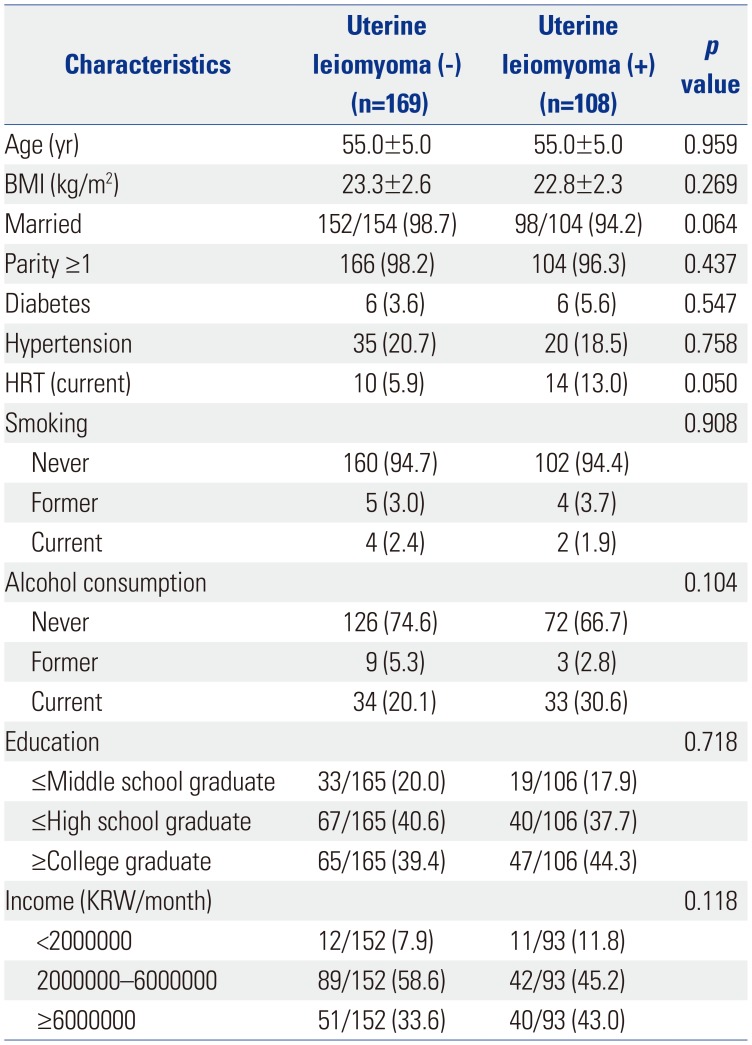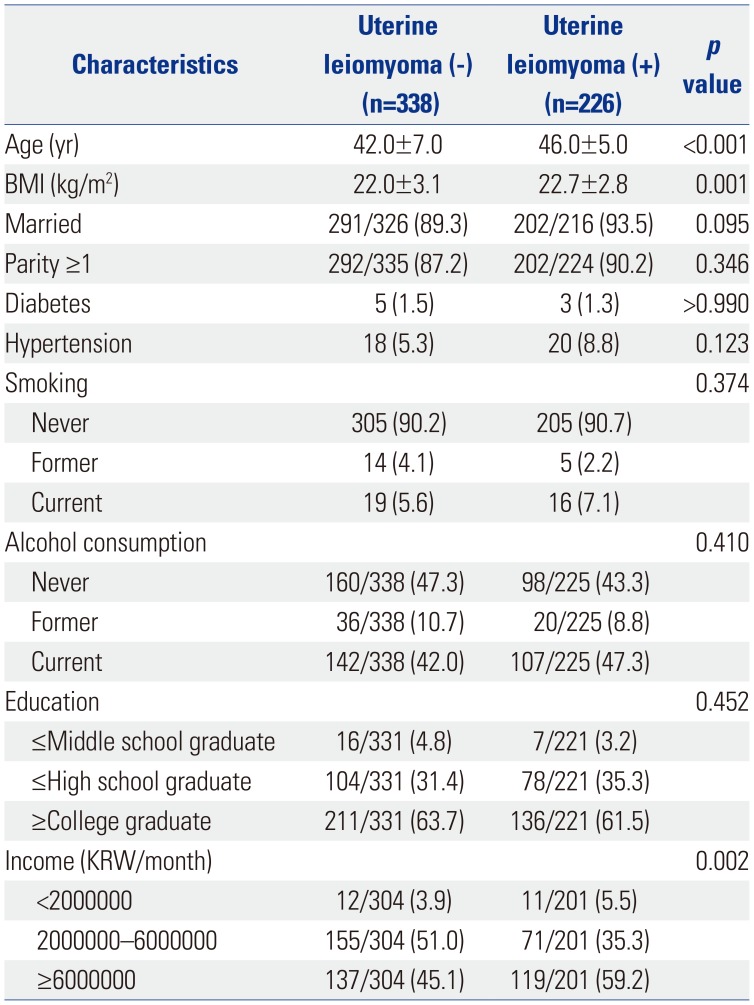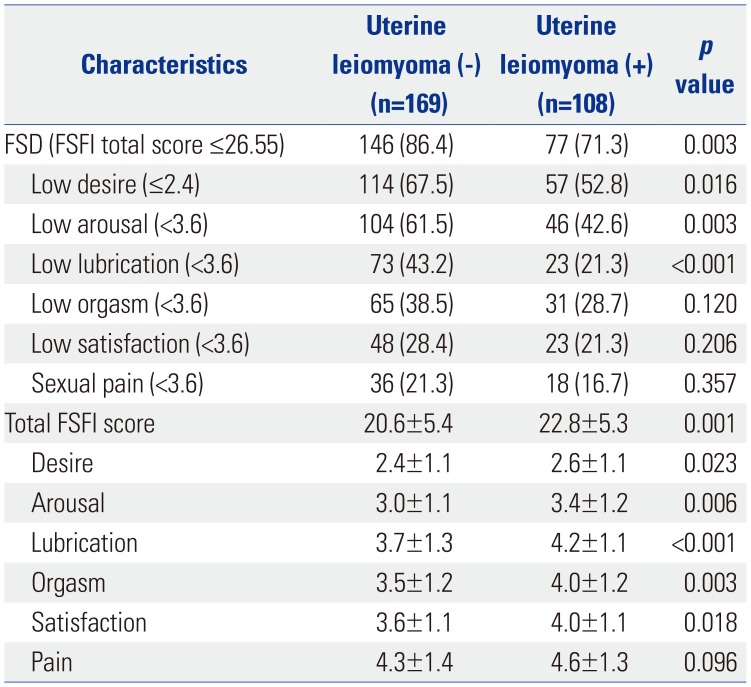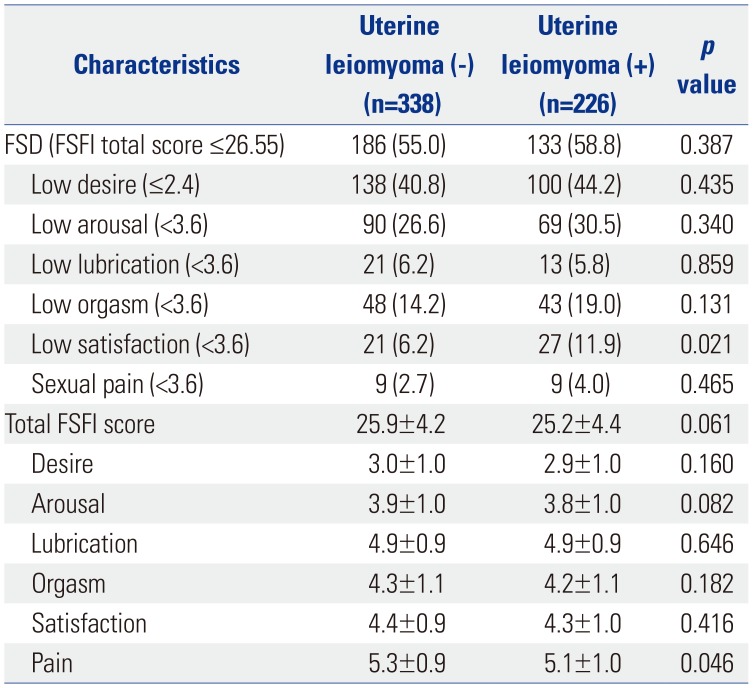1. Srivastava R, Thakar R, Sultan A. Female sexual dysfunction in obstetrics and gynecology. Obstet Gynecol Surv. 2008; 63:527–537. PMID:
18631409.

2. Sarrel PM. Sexuality and menopause. Obstet Gynecol. 1990; 75(4 Suppl):26S–30S. PMID:
2179787.

3. Kim YH, Kim SM, Kim JJ, Cho IS, Jeon MJ. Does metabolic syndrome impair sexual function in middle- to old-aged women? J Sex Med. 2011; 8:1123–1130. PMID:
21235723.

4. Choi J, Shin DW, Lee S, Jeon MJ, Kim SM, Cho B, et al. Dose-response relationship between cigarette smoking and female sexual dysfunction. Obstet Gynecol Sci. 2015; 58:302–308. PMID:
26217601.

5. Hong H, Lee HJ, Kim SM, Jeon MJ, Shin DW, Choi HC, et al. Subclinical hypothyroidism is not a risk factor for female sexual dysfunction in Korean middle-aged women. Thyroid. 2015; 25:784–788. PMID:
26110199.

6. Keye WR Jr. Psychosexual responses to infertility. Clin Obstet Gynecol. 1984; 27:760–766. PMID:
6488617.

7. Salonia A, Zanni G, Nappi RE, Briganti A, Dehò F, Fabbri F, et al. Sexual dysfunction is common in women with lower urinary tract symptoms and urinary incontinence: results of a cross-sectional study. Eur Urol. 2004; 45:642–648. PMID:
15082208.

8. Thranov I, Klee M. Sexuality among gynecologic cancer patients--a cross-sectional study. Gynecol Oncol. 1994; 52:14–19. PMID:
8307495.

9. Moshesh M, Olshan AF, Saldana T, Baird D. Examining the relationship between uterine fibroids and dyspareunia among premenopausal women in the United States. J Sex Med. 2014; 11:800–808. PMID:
24467730.

10. Ertunc D, Uzun R, Tok EC, Doruk A, Dilek S. The effect of myoma uteri and myomectomy on sexual function. J Sex Med. 2009; 6:1032–1038. PMID:
19040618.

11. Singh SS, Belland L. Contemporary management of uterine fibroids: focus on emerging medical treatments. Curr Med Res Opin. 2015; 31:1–12.

12. Schvartzman R, Bertotto A, Schvartzman L, Wender MC. Pelvic floor muscle activity, quality of life, and sexual function in peri- and recently postmenopausal women with and without dyspareunia: a cross-sectional study. J Sex Marital Ther. 2014; 40:367–378. PMID:
24279742.

13. Baird DD, Hill MC, Schectman JM, Hollis BW. Vitamin D and the risk of uterine fibroids. Epidemiology. 2013; 24:447–453. PMID:
23493030.

14. Kim HY, So HS, Park KS, Jeong SJ, Lee JY, Ryu SB. Development of the Korean-version of Female Sexual Function Index (FSFI). Kor J Androl. 2002; 20:50–56.
15. Wiegel M, Meston C, Rosen R. The Female Sexual Function Index (FSFI): cross-validation and development of clinical cutoff scores. J Sex Marital Ther. 2005; 31:1–20. PMID:
15841702.

16. Dennerstein L, Randolph J, Taffe J, Dudley E, Burger H. Hormones, mood, sexuality, and the menopausal transition. Fertil Steril. 2002; 77(Suppl 4):S42–S48. PMID:
12007901.

17. González M, Viáfara G, Caba F, Molina E. Sexual function, menopause and hormone replacement therapy (HRT). Maturitas. 2004; 48:411–420. PMID:
15283933.

18. Simon JA. Identifying and treating sexual dysfunction in postmenopausal women: the role of estrogen. J Womens Health (Larchmt). 2011; 20:1453–1465. PMID:
21819250.

19. Reed SD, Cushing-Haugen KL, Daling JR, Scholes D, Schwartz SM. Postmenopausal estrogen and progestogen therapy and the risk of uterine leiomyomas. Menopause. 2004; 11:214–222. PMID:
15021452.

20. Islam MS, Protic O, Stortoni P, Grechi G, Lamanna P, Petraglia F, et al. Complex networks of multiple factors in the pathogenesis of uterine leiomyoma. Fertil Steril. 2013; 100:178–193. PMID:
23557758.

21. Randell KM, Honkanen RJ, Tuppurainen MT, Kröger H, Jurvelin JS, Saarikoski S. Fracture risk and bone density of peri- and early postmenopausal women with uterine leiomyomas. Maturitas. 2006; 53:333–342. PMID:
16019169.










 PDF
PDF ePub
ePub Citation
Citation Print
Print



 XML Download
XML Download